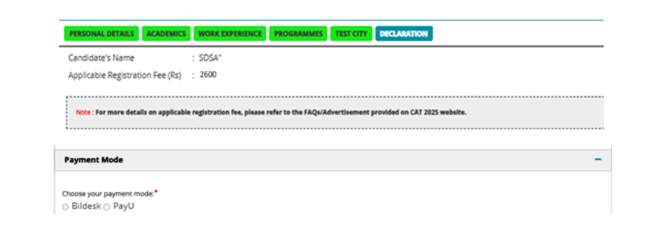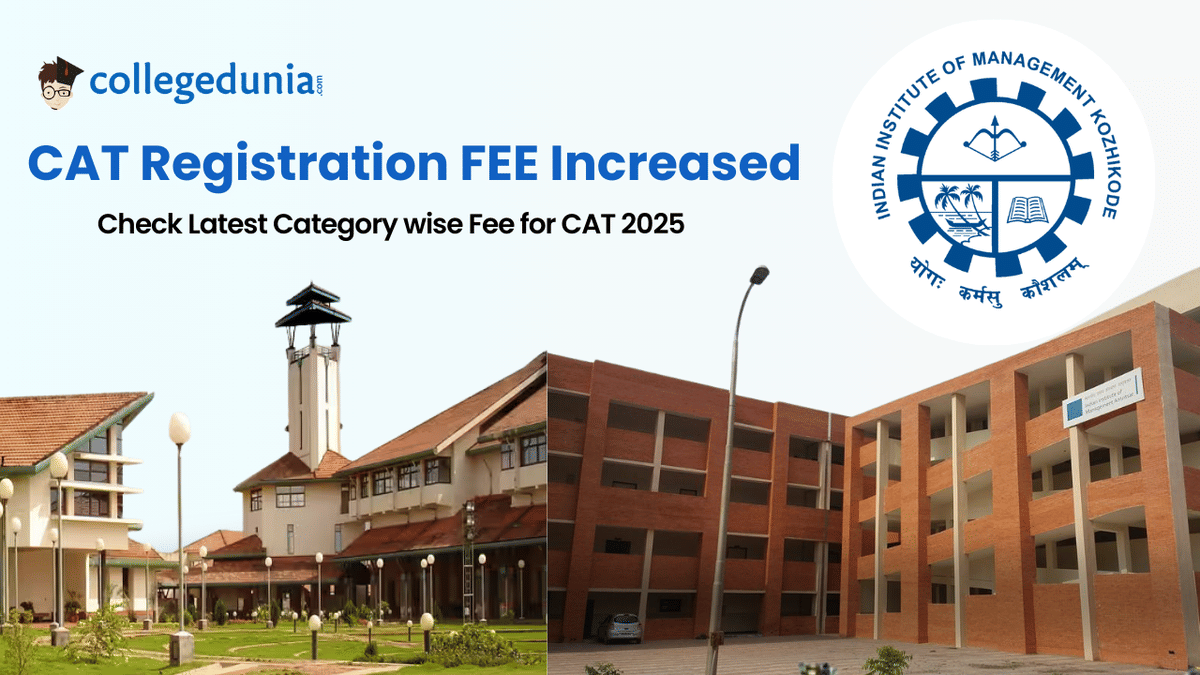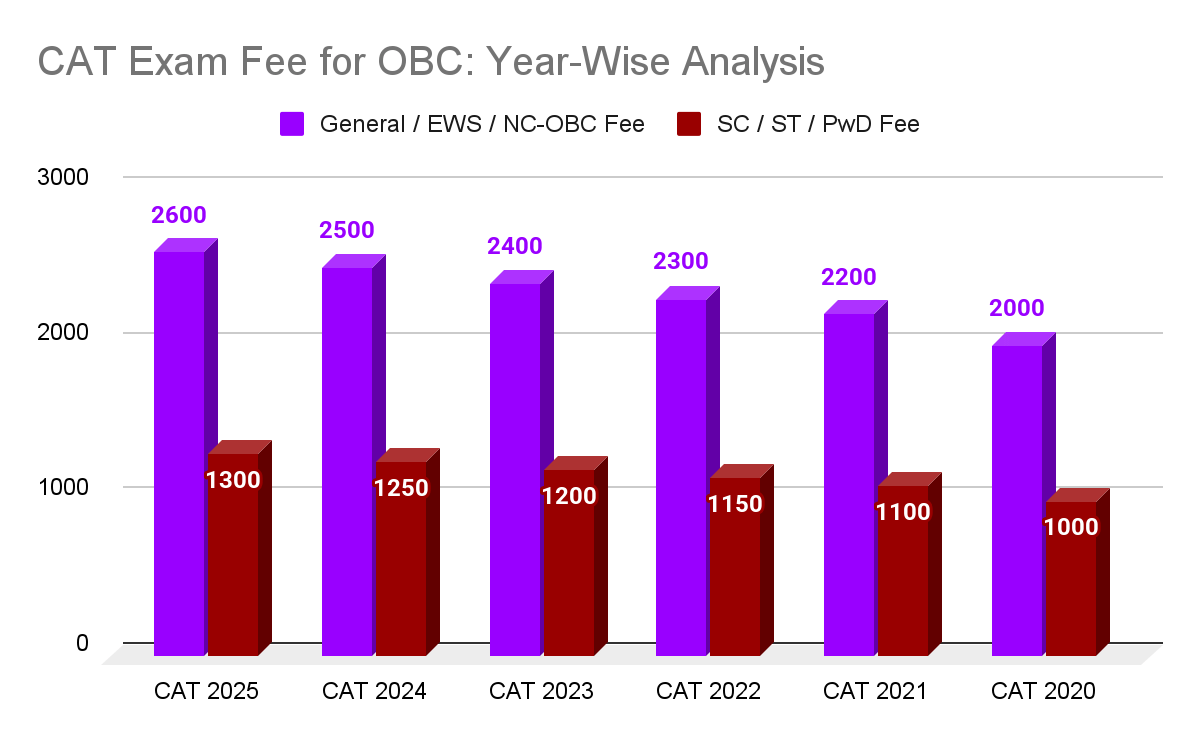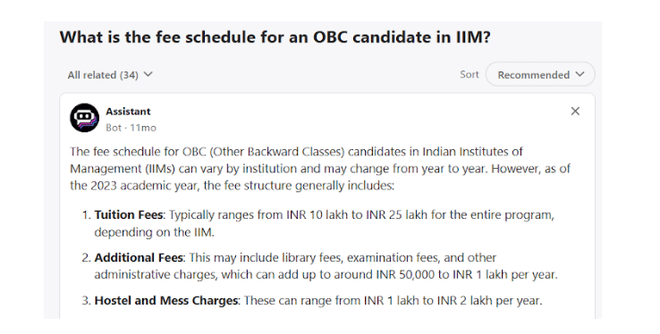The CAT exam fee for an OBC candidate is INR 2600, while it's INR 1300 for SC, ST and PwD category candidates. The CAT exam fees for the General category are the same as those of the CAT exam Fee for OBC, which is 2600 INR.
CAT exam fees for girls belonging to OBC need to pay the same fee, which is 2600 INR.
The CAT exam 2025 registration date is expected in August 2025, with the CAT registration last date on 13th September 2025. The CAT exam date 2025 will be on 30th November. Students should check the official portal for CAT exam registration 2025 updates

Also Read
Key Summary
- For CAT 2025, the exam fee for OBC (NC-OBC) candidates is ₹2,600. This is the same as General and EWS candidates, since there is no fee concession for OBC.
- The fee was increased by ₹100 this year. Earlier, it was ₹2,500 for General/OBC/EWS. The last date to pay the fee is September 13, 2025.
- While OBC candidates don’t get a lower fee, they do get an advantage during IIM admissions.
- At the top IIMs (Ahmedabad, Bangalore, Calcutta), the OBC cutoff is usually around 75 percentile overall, with sectional cutoffs in the 65-70 percentile range. Newer IIMs sometimes shortlist OBC candidates at even 60+ percentiles.
- To use the OBC reservation, candidates must upload a valid OBC-NCL certificate in the official format.

CAT Exam Fee for OBC (NC-OBC) Candidates
CAT exam fee for OBC (NC-OBC) candidates is 2,600 INR. It is the same as that for the General category. Despite OBC status, there is no concession or reduced fee.
In CAT 2025, the exam fee for OBC candidates has been increased by 100 INR compared to 2024, going up from 2,500 INR to 2,600 INR.
CAT 2025 Fee Details
| Category | CAT Application Fee (2025) |
|---|---|
| NC-OBC | ₹2,600 |
| General | ₹2,600 |
| EWS | ₹2,600 |
| SC / ST / PwD | ₹1,300 |

CAT Exam Fee for OBC: Yearwise Analysis
| CAT Exam Year | General / EWS / NC-OBC Fee | SC / ST / PwD Fee |
|---|---|---|
| CAT 2025 | INR 2600 (+4.0%) | INR 1300 (+4%) |
| CAT 2024 | INR 2500 (+4.2%) | INR 1250 (+4.2%) |
| CAT 2023 | INR 2400 (+4.3%) | INR 1200 (+4.3%) |
| CAT 2022 | INR 2300 (+4.5%) | INR 1150 (+4.5%) |
| CAT 2021 | INR 2200 (+10%) | INR 1100 (+10%) |
| CAT 2020 | INR 2000 | INR 1000 |

CAT Exam 2025 Registration Date
The CAT exam fee for OBC candidates is 1,200 INR, and they can register between August 1 and September 13, 2025, for the exam scheduled on November 30, 2025/
| Event | Date |
|---|---|
| CAT 2025 Registration Start | August 1, 2025 |
| CAT 2025 Registration End | September 13, 2025 |
| CAT 2025 Exam Date | November 30, 2025 |
Also Read
CAT Registration 2025 (Begins)What is the CAT Exam Syllabus?
The CAT Syllabus PDF has 3 sections: VARC, DILR, and QA. A total of 68 questions will be asked from the CAT Syllabus, with 24 from VARC, 22 each from DILR and QA.
Also Read
CAT Document RequiredHow to Pay the CAT Exam Fee for OBC?
Students should complete the steps mentioned below to complete the registration process by paying the CAT exam fee for OBC.
| Step | Process Description |
| Step 1: Registration | Visit the official CAT website and create a login by providing your email ID, mobile number, and date of birth. |
| Step 2: Application Form | Fill in details such as personal information, academic background, work experience (if any), program selection, and preferred test cities. |
| Step 3: Document Upload | Upload scanned copies of your photograph, signature, and category certificates (if applicable) as per the prescribed size and format. |
| Step 4: Fee Payment | Pay the CAT 2025 registration fee online through debit card, credit card, or net banking. Once the payment is successful, a confirmation will be generated. |
Also Read
CAT Registration 2025CAT Exam Fee for OBC: Reddit, Quora Snippets
On Quora and Reddit, CAT aspirants often talk about the exam fee for OBC candidates, which is 2,600 INR. Unlike SC/ST/PwD students, who pay just 1,300 INR, OBC candidates don’t get any fee concession.
At the same time, discussions highlight that the real benefit for OBC candidates lies in reduced IIM cutoffs (75-82 percentile vs 85+ for General) rather than in the fee structure.
Even students discuss about the scholarship for OBC students at IIMs as well as fee structure of IIMs for OBC candidates.


Also Read
FAQs on CAT Exam Fee for OBC
FAQs on CAT Exam Fee for OBC
Ques. Is the CAT exam free of cost?
Ans. No, the CAT exam is not free. Every candidate must pay the registration fee. As of 2025, the CAT exam fee for OBC (NC-OBC) candidates is ₹2,600. It’s the same as the General and EWS categories. Only SC, ST, and PwD candidates receive a fee concession and pay ₹1,300. This fee is non-refundable under almost all circumstances.
Ques. Does paying the CAT exam fee for OBC guarantee reservation benefits?
Ans. No. Paying the CAT exam fee for OBC simply means you belong to the NC-OBC category and are paying the correct fee. Reservation benefits apply only during the admission process, not in fee structure. You must submit a valid, government-prescribed and recently issued OBC-NCL certificate during the IIM admission process to claim a reservation. Candidates from the OBC Creamy Layer are treated as General category applicants.
Ques. Is there an upper age limit for CAT?
Ans. No, there is no upper (or lower) age limit for appearing in CAT. All candidates, regardless of age are eligible as long as they meet the minimum educational criteria: a bachelor’s degree with at least 50% marks (or 45% for SC/ST/OBC/PwD). Final-year students are also eligible to apply.
Ques. How much is the CAT exam fee for OBC, and how does this compare to other categories?
Ans.
- CAT exam fee for OBC (NC-OBC): ₹2,600
- General/EWS: ₹2,600
- SC/ST/PwD: ₹1,300
This reflects a ₹100 increase from 2024 for General/OBC/EWS, and a ₹50 increase for SC/ST/PwD categories.
Ques. Can I pay the CAT exam fee for OBC using offline methods?
Ans. No. The CAT exam fee for OBC must be paid online. Accepted methods include credit/debit cards, net banking, UPI and mobile wallets. Be mindful of associated transaction charges. For example, credit cards may incur ~1.2%, debit cards 0.75-0.90%, and net banking may charge a flat ₹20 per transaction.







Comments